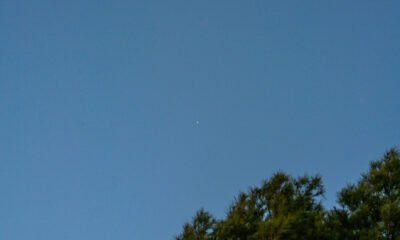News
Tucson Astronomers Monitor Asteroid with Slim Chance of Colliding with Earth in 2032

On Christmas Day last year, Earth experienced a close encounter with a midsized asteroid, designated 2024 YR4. The asteroid passed within 828,000 kilometers of our planet, raising concerns about potential future collisions.
Astronomers estimate a 2 percent chance of 2024 YR4 impacting Earth on December 22, 2032. However, astronomer David Rankin, affiliated with the Catalina Sky Survey atop Mount Lemmon, reassures the public. “This is definitely nothing to lose sleep over,” he remarked. He emphasized that the likelihood of dying from an asteroid impact is far less than that of a car accident or even a lightning strike.
Should 2024 YR4 collide with Earth, Rankin explained that it would not result in an extinction-level event similar to the asteroid that wiped out the dinosaurs. This asteroid is significantly smaller, with an estimated size of 40 to 90 meters in diameter, compared to the 10-kilometer-wide asteroid responsible for the dinosaur extinction. However, it could still pose a serious localized threat depending on its impact site.
If the asteroid were to strike land, it could cause considerable destruction, particularly across regions in northern South America, Sub-Saharan Africa, and India. Rankin noted that an ocean impact might generate tsunamis, though detailed modeling on such outcomes is required.
2024 YR4 is classified as a “stony type” asteroid composed of silicate rocks and nickel-iron. This differs from the nickel-iron asteroid that created Meteor Crater in Flagstaff, which left a mile-wide crater after not disintegrating during atmospheric entry.
In the event of an Earth impact, Rankin described how the asteroid would generate a fireball upon entering the atmosphere, heating the surface to extreme temperatures. “You’ll get this fireball that hits the surface of the ground and just bakes everything around it at like 1,000 degrees,” he stated.
The asteroid was first detected by the ATLAS network’s Chilean station on December 27. Subsequent observations by the Catalina Sky Survey confirmed its trajectory. Astronomers plan to use the James Webb Space Telescope for further analysis in March and will reevaluate its path during another close approach in December 2028.
Currently, nearly 40,000 near-Earth asteroids have been cataloged by NASA. The Catalina Sky Survey, part of the University of Arizona’s Steward Observatory, collaborates with ATLAS, which monitors the skies for potentially hazardous asteroids.
Rankin highlighted that astronomers have identified over 90 percent of Earth-threatening asteroids larger than 1,000 kilometers. However, the situation is different for smaller asteroids, such as 2024 YR4, where hazards to regional safety are more prevalent.
“When you get down to smaller rocks, the numbers aren’t so pretty,” Rankin cautioned. He mentioned that asteroids capable of causing regional devastation are difficult to track, especially since many pass unnoticed during daylight hours. “Yes, at any moment that could happen anywhere on the planet, then cause massive devastation, and we would have never seen that asteroid before.”






![Frank Fierro stands in front of a 90-acre sunflower crop on Ralston Road, just south of State Route 238, on June 2, 2025. [Monica D. Spencer]](https://arizonanews.org/wp-content/uploads/2025/06/Colorful-Photo-Spot-Blooms-Again-A-Second-Chance-After-Last-400x240.jpg)
![Frank Fierro stands in front of a 90-acre sunflower crop on Ralston Road, just south of State Route 238, on June 2, 2025. [Monica D. Spencer]](https://arizonanews.org/wp-content/uploads/2025/06/Colorful-Photo-Spot-Blooms-Again-A-Second-Chance-After-Last-80x80.jpg)










